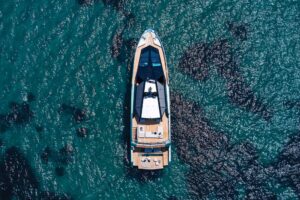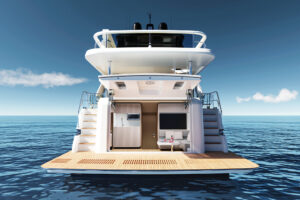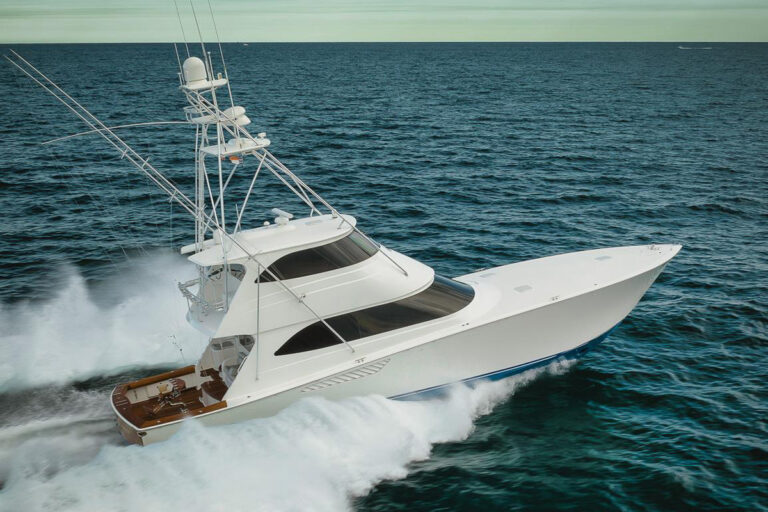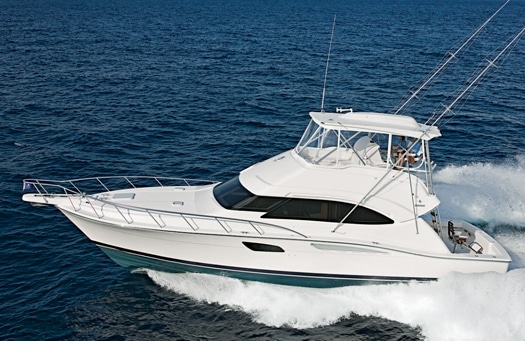
ytgfeb19bert511525.jpg
I believe Oldsmobile coined the tag line that came to mind when I saw the first drawings of the new Bertram 511: “She’s not your father’s Bertram.” I have been a Bertram fan since I could think straight and a Bertram owner for almost 20 years, so I admit a certain bias for old favorites. However, when a boat like the 511 comes along, even an old #%@* like me takes notice. She is an excellent example of the refined and focused “new Bertram.”
I think much of my enthusiasm for the 511 is that she has a familiar feel. The 511 replaces the 510, which was Bertram’s first new offering following its acquisition by the Italy-based Ferretti Group in 1998. I tested the 510 back then, but the familiar feel I mention comes from the fact that the 510 and the 511 were built on a hull form created for the Bertram 50 Convertible introduced in 1987. The 50 was essentially a scaled-down version of the legendary Bertram 54 Convertible, which arguably remains one of the best sea boats afloat.
While much is made of Bertram’s pioneering efforts with the deep-V hull form, the fact is that by the 1980s Bertram engineers had realized that what most call “deep” (20-plus degree transom deadrise) did not make sense on a 50-foot convertible. Bertram engineers compromised and melded a deep entry with a transom deadrise of about 17 degrees. They also avoided the trend to increase chine beam forward. The result is a design geared toward performance -not a party barge.
While seas during our trials were not challenging, I expect from experience that the 511 will deliver a dry, comfortable ride in rougher going. That old familiar feel passed astern as I moved the throttles forward. The 511’s electronically controlled pair of 1,360-horsepower MANs responded without fuss or smoke, delivering a maximum speed of 38.3 knots. Bertram had designed the 50’s hull for speeds in excess of 40 knots and, cranked up, the 511 tracks well, turns precisely, and displays no bad habits. She can cruise all day at more than 30 knots.
In the 1980s, Bertram engineers were crunching numbers while most production builders were developing their scantlings using empirical methods-if it breaks, add more fiberglass. It was also one of the first production builders to embrace new materials like stitched biaxial fiberglass, carbon fiber, and coring. Today, Bertram and Ferretti Group engineers work together sharing notes and methods. The 511’s hull is built with a solid bottom. Foam coring is used above the chine and in the superstructure and decks. Exposed bilge areas are gelcoated and her machinery space is faired and finished. The clean look is in keeping with current fishboat market standards.
The 511’s systems appear organized, clutter free, and are less complicated than was typical in the past. For example, instead of splitting the fuel load in tanks fore and aft and plumbing a complicated fuel management system, the 511 has a single fiberglass tank forward of the engines. Balance is achieved by positioning the generator(s) aft of the engines and locating the 185-gallon water tank under the cockpit. This arrangement leaves more space to move about the engines and the fuel tank serves as a sound buffer between the machinery space and the accommodations forward.
Like all new Bertrams, the 511’s exterior styling and interior design were crafted by Zuccon International. The Italian firm has had a close working relationship with the Ferretti Group since the 1990s. While Bertram has always pushed the styling envelope in the conservative American fishboat market, Zuccon’s designs have taken things even further. Swooping house and bridge lines, ducktail bridge reverses, and house face and hullside windows are clearly a derivative of the stylish Italian motoryacht market. These details are molded in new tooling that has raised Bertram’s standard in fit and finish.
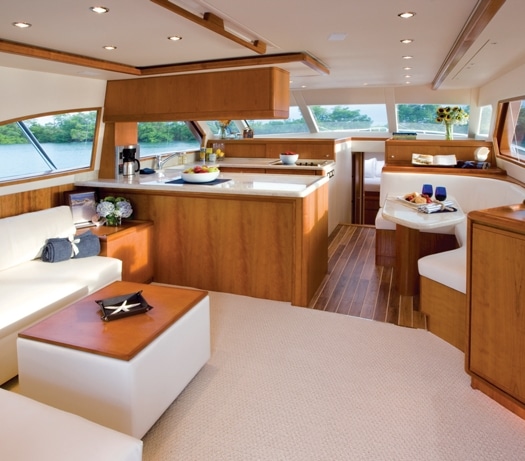
| | |
Our test boat was outfitted for fishing with a half tower, outriggers, and a full-size fighting chair. Her cockpit is fitted with a transom door that can be used for fishing or swimming. A teak cockpit sole and coaming are offered, as is a swim platform. There is a transom fishbox, as well as a large in-sole fishbox. A teak-soled mezzanine is a popular update. The raised seating area allows observers to enjoy the fishing action without being underfoot. Space within includes a drink box, stowage, and an insulated box that can serve as a freezer. There is also space for a livewell and a small tackle center. Our test boat’s bridge was arranged with a tournamentstyle helm, with companion seating facing a power-actuated, pop-up electronics console. The U-shaped seating forward has stowage within, including a spot to tuck a liferaft.
The 511’s three-stateroom, two-head arrangement has an amidships master stateroom with a queen island berth and a private head. A forward stateroom has a queen island berth and shares a head with a third stateroom with side-by-side berths. In the American market upper and lower berths would be more typical. In the main cabin the L-shaped settee faces forward instead of aft as it did on the 510. Trading the view out the bulkhead window in favor of a more integrated entertaining space seems sensible. As is the case with the 511’s smaller sister (410) and larger sister (540), Bertram includes a standard windshield and offers an optional lower helm station. These features are reminiscent of a time that has passed in American convertible design, but is apparently still popular in Europe. (Bertram also offers a no-windshield option.)

| | |
Bertram’s focus with the 511 and her sisters extends far beyond our shores. The Bertram brand has always been popular overseas and the crossbreeding of American and Italian design has no doubt reinforced this connection. The 511 is truly a hybrid that could be at home chasing billfish in the Bahamas or exploring the Mediterranean seacoast. Whatever waters she wanders, she will deliver the strong performance Bertram fans expect.
Bertram Yacht, (305) 633-8011; **www.bertram.com**

